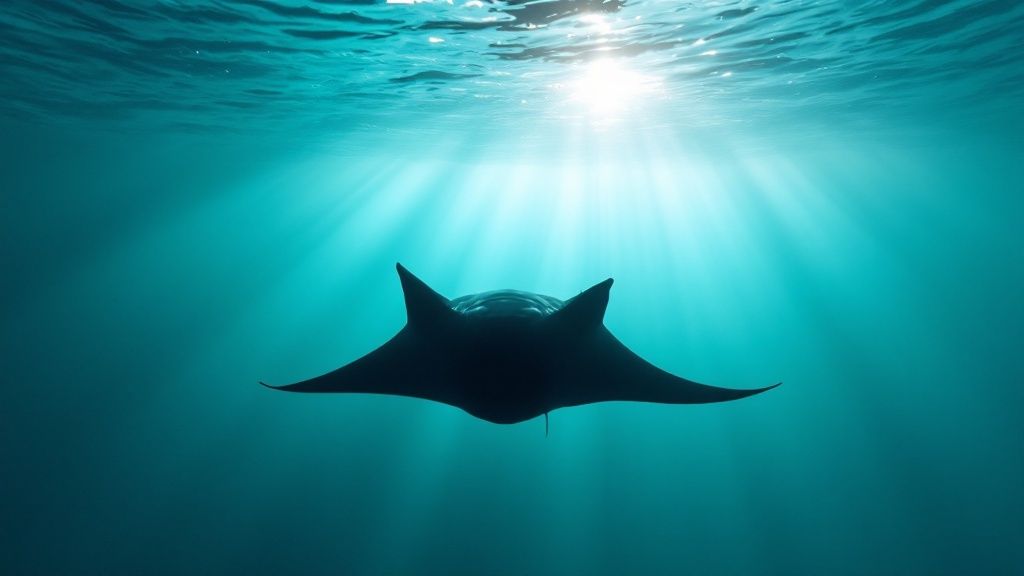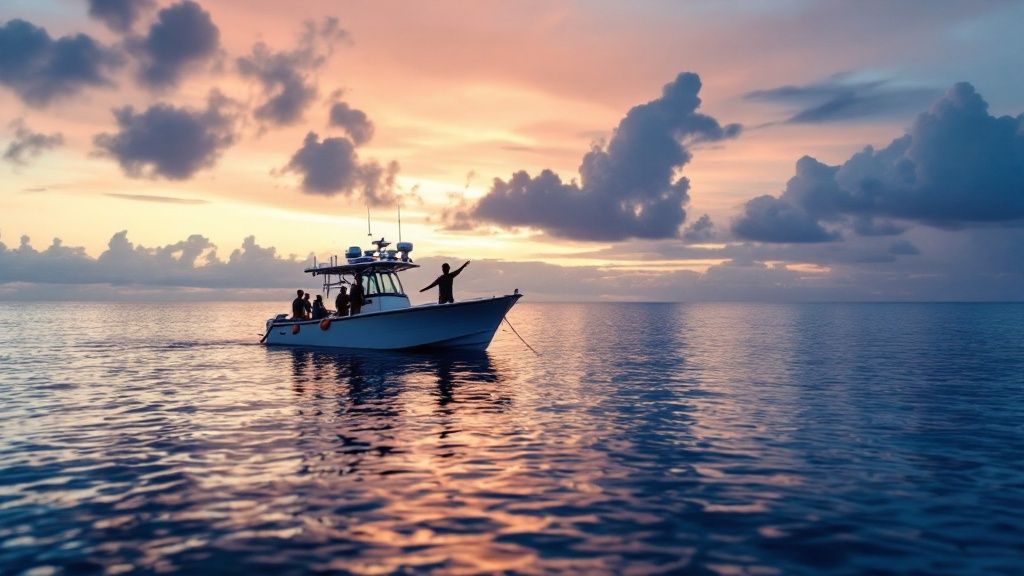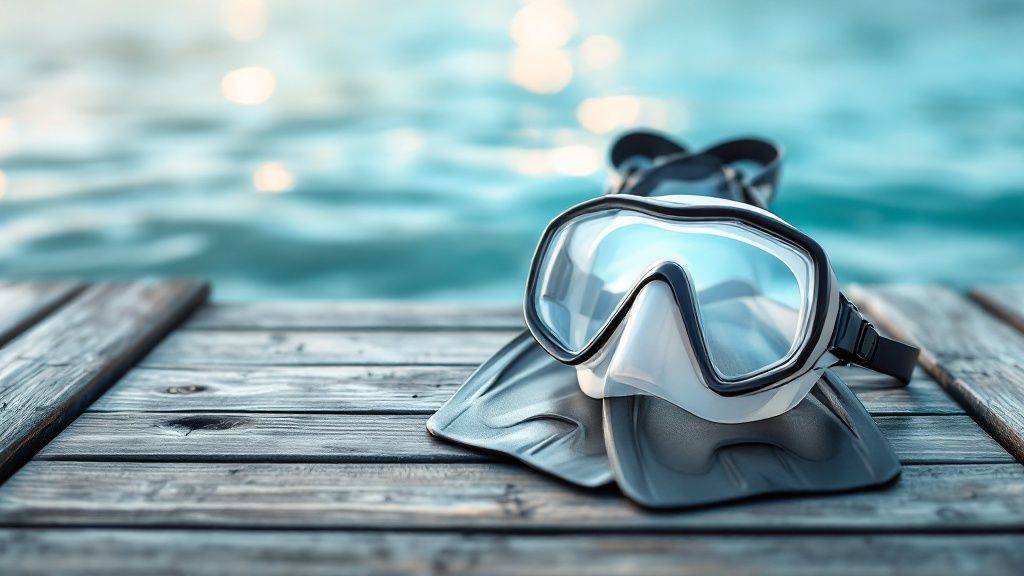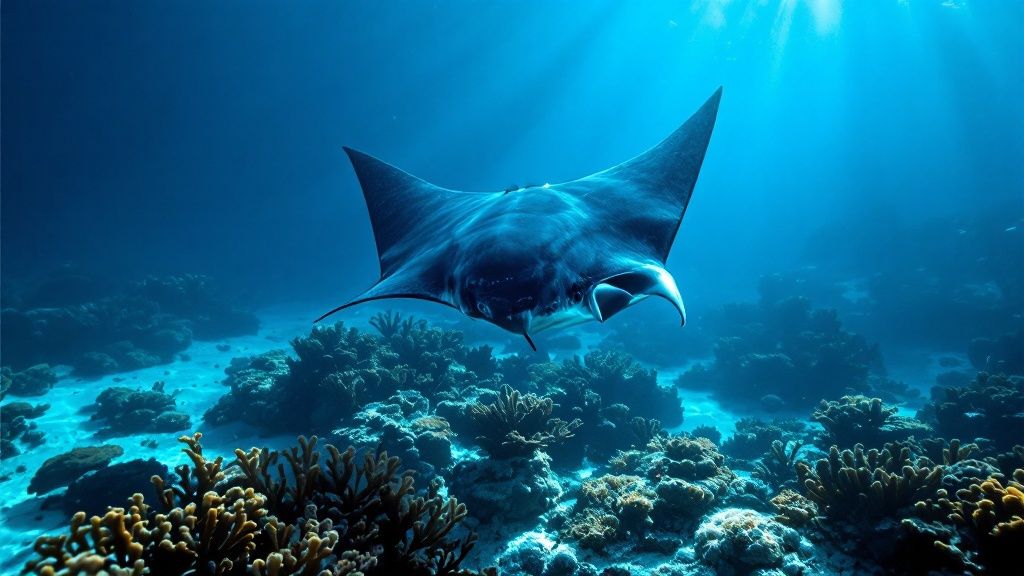Manta Ray Snorkel Kona: Your Ultimate Underwater Adventure
- Byron
- May 26
- 11 min read
Why Kona Dominates The Manta Ray Snorkeling Scene

The Big Island of Hawai'i offers many incredible marine encounters, but manta ray snorkeling in Kona is truly special. What makes Kona such a hotspot for these gentle giants? It's a unique combination of geology and a thriving ecosystem.
The Perfect Recipe for Manta Ray Encounters
Kona's volcanic coastline plays a crucial role. Volcanic activity creates nutrient-rich upwellings that bring plankton to the surface. This plankton is the main food source for manta rays. These upwellings, combined with the warm, clear waters, create the perfect feeding ground. The sheltered bays along the Kona coast also provide calm, protected areas ideal for both mantas and snorkelers.
This means plenty of food for manta rays in a safe, comfortable environment. For snorkelers, these calm bays mean easy entry and exit from the water, with clear visibility to enjoy the show. This unique combination makes Kona a top manta ray snorkel destination. The Kona Coast boasts an impressive 85-90% sighting success rate year-round for manta ray night dives. This means 8 to 9 out of 10 snorkelers are likely to see manta rays, making it a highly reliable destination. Find more detailed statistics here: Learn more about Kona Manta Ray sightings
Conservation Efforts Contribute to Thriving Manta Populations
Kona's success isn't just natural; it's also due to dedicated conservation efforts. Strict guidelines and responsible tourism practices ensure minimal disruption to the manta rays' habitat. This focus on sustainability protects the mantas and helps maintain the health of the entire reef.
This careful approach benefits the manta rays and enhances the snorkeling experience. Respectful interactions allow for closer, more natural encounters with these graceful creatures. Kona is a global model for manta ray conservation and provides snorkelers with unparalleled opportunities for observation.
The Underwater Topography of Kona: A Manta Ray Paradise
The underwater topography of Kona also plays a key role. The sloping seafloor, combined with the upwellings, creates a natural feeding arena. The deeper channels allow mantas to navigate easily, while shallower areas concentrate plankton, creating a perfect feeding zone. These unique underwater features, along with consistent currents, create optimal conditions for both the mantas and the people who come to see them.
Meet Your Swimming Companions: Manta Ray Insights
Before you head out on your manta ray snorkel Kona adventure, let's explore the captivating world of these gentle giants. Manta rays are much more than just large fish; they possess impressive intelligence, curiosity, and distinct personalities that make encounters truly special.
Understanding Manta Ray Behavior
Manta rays display complex behaviors, from their feeding habits to their social interactions. Their diet primarily consists of plankton, which they consume through a process called filter feeding. They gracefully glide through the ocean with their mouths open, filtering these tiny organisms from the water.
Beyond their feeding strategies, manta rays have shown remarkable problem-solving skills. Some even appear to recognize individual humans. This intelligence distinguishes them from many other ocean inhabitants.
These gentle giants can also live for over 50 years, developing intricate social structures over their long lifespans. Research from organizations like the Manta Pacific Research Foundation continues to reveal insights into their social dynamics and communication.
Kona's Coastal Zones: A Manta Ray Haven
Kona's unique coastal zones provide an ideal habitat for manta rays. The volcanic coastline creates nutrient-rich upwellings, ensuring a plentiful supply of plankton. This reliable food source, along with the calm, sheltered bays of the Kona coast, offers the perfect environment for these magnificent creatures.
These protected bays also serve as the setting for their intricate mating rituals, solidifying Kona's reputation as a manta ray haven.
Cleaning Stations and Social Interactions
Another intriguing aspect of manta ray behavior is their use of cleaning stations. These are designated areas on the reef where smaller fish meticulously remove parasites and dead skin from the mantas. This mutually beneficial relationship showcases the interconnectedness of the reef ecosystem.
Witnessing these cleaning stations during a manta ray snorkel Kona tour offers a special glimpse into the social complexities of these creatures. It enriches the experience and adds another layer of appreciation for the delicate balance of life beneath the waves.
Manta Village Vs Manta Heaven: Choosing Your Perfect Spot

Kona offers two amazing locations for manta ray snorkeling: Manta Village and Manta Heaven. Each spot provides a unique experience, perfect for different skill levels and preferences. Picking the right one can make your manta ray encounter even more special.
Manta Village: The Beginner-Friendly Option
Located near the airport, Manta Village is known for its shallow, sandy bottom, typically around 30-40 feet deep. This makes it a great spot for families with children and less confident swimmers.
Manta rays are consistently seen in this area, making it a reliable choice. The abundance of plankton, attracted by the lights from nearby resorts, and the location's proximity to the coast contribute to this predictability.
Manta Heaven: An Adventure for Experienced Snorkelers
If you're looking for a more thrilling manta ray snorkeling adventure, Manta Heaven is your destination. Further offshore, it features deeper water (around 40-50 feet) and more dramatic underwater scenery, often with larger groups of manta rays.
The deeper water and occasional stronger currents might be challenging for beginners. However, experienced snorkelers will appreciate the extra space it allows the mantas to maneuver, creating a more dynamic experience.
You might be interested in: Top Encounters on the Big Island
Factors Influencing Your Choice
Besides depth and experience level, other factors can help you decide between the two sites.
Water Visibility: While both locations usually have great visibility, conditions can change due to weather and plankton density.
Group Sizes: Manta Heaven can sometimes attract larger groups of both mantas and snorkelers, while Manta Village often has smaller, more intimate groups.
Accessibility: Manta Village's closer proximity to shore means less boat travel time.
To help you choose the best spot for your manta ray snorkel Kona adventure, we've put together a comparison table highlighting the key differences and similarities between Manta Village and Manta Heaven.
Manta Village vs Manta Heaven Comparison: A comprehensive comparison of Kona's two premier manta ray snorkeling locations, including water depth, accessibility, and experience level recommendations
Feature | Manta Village | Manta Heaven |
|---|---|---|
Depth | Shallow (30-40 ft) | Deeper (40-50 ft) |
Experience Level | Beginner-friendly | More experienced snorkelers |
Manta Activity | Consistent | Potentially larger groups |
Group Size | Often smaller, more intimate groups | Can attract larger groups of snorkelers |
Accessibility | Closer to shore, shorter boat ride | Further offshore, longer boat ride |
As you can see, both Manta Village and Manta Heaven offer incredible opportunities to witness these majestic creatures. The best choice for you depends on your comfort level and what you're hoping to experience. Either location promises a truly memorable encounter with manta rays in their natural habitat.
Planning Your Perfect Manta Ray Encounter Strategy
Exceptional manta ray snorkel Kona experiences begin with careful planning. Choosing the right tour operator is essential for a truly memorable adventure. This means considering key factors like group size, guide expertise, safety protocols, and equipment quality.
Choosing the Right Tour Operator
Smaller groups allow for more personal and less intrusive interactions with the manta rays. Experienced guides enhance your understanding of manta ray behavior and prioritize your safety. For advice on the best time of year to visit, check out our guide on the best time to see manta rays in Kona.
Thorough safety briefings and adherence to established protocols are vital. High-quality equipment, such as well-maintained wetsuits and masks, contributes to a comfortable and enjoyable experience. All of these elements combine to create a positive and enriching snorkeling adventure.
Booking and Seasonal Considerations
Booking your manta ray snorkel Kona tour ahead of time is highly recommended, particularly during peak season. This secures your spot and allows for better preparation. Understanding seasonal variations in manta ray activity can also impact your trip planning.
For instance, specific times of the year might offer increased opportunities to see larger groups of mantas. Weather conditions also play a role; calm seas and clear visibility create ideal viewing conditions.

Preparing for Your Snorkel
Even seasoned snorkelers should prepare for the unique aspects of a night snorkel with manta rays in Kona. Understanding the physical requirements and any potential challenges will contribute to a more relaxed experience.
While snorkeling is generally accessible, some tours might involve deeper water or stronger currents. Select a tour that aligns with your comfort and skill level. Familiarize yourself with the provided equipment and any specific instructions from your guide. This preparation will allow you to fully appreciate the magical encounter that awaits.
Your Underwater Adventure: What Actually Happens
Picture this: you're floating in Kona's warm waters, massive, graceful shadows gliding beneath you. What's it really like to experience a manta ray snorkel Kona adventure? Let's break down a typical evening, from beginning to end.
Preparing for the Encounter
Your adventure starts with a safety briefing and equipment fitting. Tour operators provide wetsuits, masks, snorkels, and flotation devices. Guides carefully explain how everything works, ensuring a comfortable and safe experience, even if you're a first-time snorkeler. This includes crucial information on how to interact responsibly with the manta rays. For instance, you’ll learn to avoid touching them, as this can harm their protective mucus layer.
Arrival at the Manta Ray Viewing Site
After the briefing, you'll board a boat headed for either Manta Village or Manta Heaven. The location depends on ocean conditions and manta ray activity. Once you arrive, the magic truly begins. Powerful underwater lights are strategically placed to attract plankton, the manta rays' main food source. These lights create a breathtaking underwater scene, illuminating the mantas' graceful movements as they dine.
Observing the Manta Ray Ballet
As the plankton gathers, the manta rays appear, sometimes in large groups. Their feeding behavior is a captivating spectacle. They perform underwater ballets, gracefully looping and swirling as they eat the plankton. It's a surreal experience watching these gentle giants, some with wingspans up to 18 feet, glide effortlessly through the illuminated water.
Learn more in our article about the magic of a manta ray night snorkel.
Respecting the Marine Environment
Throughout the adventure, the guides emphasize conservation guidelines and responsible interaction. Keeping a safe distance from the mantas is essential for their well-being and allows them to continue feeding naturally, undisturbed. You’ll learn how to position yourself in the water for the best views without interfering with the mantas. This might involve holding onto a flotation device and facing downwards so the mantas can swim below you. Divers are instructed to stay on the ocean floor, shining their lights upwards to attract plankton.
The Emotional Impact
Many people feel a deep emotional connection during their first close encounter with manta rays. The sheer size and grace of these animals, combined with the almost mystical atmosphere of a nighttime snorkel, makes for a truly unforgettable experience. The underwater sounds, their elegant movements, and the close proximity create a lasting impression and a deeper appreciation for the marine world. Practical tips from your guides will help you relax and enjoy your time with these amazing creatures. For example, regulating your breathing and minimizing splashing keeps the environment calm, allowing the manta rays to continue their mesmerizing display.
Supporting Manta Ray Research and Conservation Efforts
Your manta ray snorkel Kona adventure offers more than just a thrilling experience. It directly supports vital research and conservation initiatives, protecting these majestic creatures for future generations. This sustainable tourism model helps ensure the long-term health of the manta ray population and the entire reef ecosystem.
Photo Identification and Tracking
One crucial aspect of manta ray research is photo identification. Researchers and citizen scientists take pictures of the unique spot patterns on each manta's underside. These patterns act like fingerprints, allowing researchers to track individual mantas throughout their lifespans, which can be longer than 50 years.
This ongoing monitoring provides invaluable data on population size, movement patterns, and individual manta ray behavior.
Historical Data Insights
Historical data on manta ray sightings in Kona offers valuable insights into their behavior and habitat usage. From 2009 to 2014, underwater videographers meticulously documented manta ray sightings at locations like Manta Village and Manta Heaven. Find more detailed statistics here.
Collaborative Research Efforts
Local tour operators, marine biologists, and international conservation organizations collaborate on research projects. This collaborative approach maximizes data collection and ensures that conservation strategies use the latest scientific findings.
Your participation in a manta ray snorkel Kona tour contributes to this collaborative effort. Every encounter provides researchers with valuable information about behavior patterns, population health, and habitat usage.
Funding Conservation Through Tourism
Responsible tourism is crucial for funding these research and conservation initiatives. The revenue generated from manta ray tours directly supports several key areas:
Marine Protected Areas: Creating and maintaining safe havens for manta rays and other marine life.
Research Equipment: Investing in technology like underwater cameras and tracking devices.
Educational Programs: Raising awareness about the importance of manta ray conservation.
This model demonstrates how sustainable tourism can benefit both the local economy and the environment.

Kona: A Model for Sustainable Tourism
Kona's success in balancing tourism with conservation offers a positive example for other regions facing similar challenges. The collaborative approach, combined with strict regulations and responsible tour operator practices, serves as a model for sustainable tourism that benefits both people and wildlife.
By choosing a manta ray snorkel Kona adventure, you become a citizen scientist. Your presence contributes to databases that inform protection strategies worldwide and helps ensure a future for these magnificent animals.
Maximizing Your Kona Manta Ray Adventure Impact
Transforming your manta ray snorkel Kona experience into a lasting memory goes beyond simply booking a tour. It's about responsibly capturing the magic and contributing to the conservation of these gentle giants.
Documenting Your Encounter
Preserving the memories of your manta ray encounter can be achieved in several ways. Photography is a popular choice, but remember to be respectful and avoid flash photography. Flash can startle the mantas. Adjust your camera settings for low-light conditions and focus on capturing their natural beauty without disturbing their feeding.
Keep a journal to record your personal experience. Jot down your emotional responses, the specifics of the encounter, and any unique behaviors you notice. This creates a more meaningful memento than just a snapshot.
Supporting Ongoing Research and Conservation
Your involvement doesn't end when you depart Kona. Many organizations devoted to manta ray research rely on citizen science. Sharing your photos with these research groups allows for identification and tracking. Donating to organizations like the Manta Pacific Research Foundation directly contributes to conservation work.
Responsible social media sharing also plays a crucial role. Spread awareness about the importance of manta ray conservation and encourage others to select sustainable tour operators when visiting Kona.
Enhancing Your Big Island Experience
Expand your marine adventure by exploring other activities on the Big Island. Visiting research centers like the Manta Learning Center at the Sheraton Kona Resort offers deeper insights into manta ray biology and behavior. Exploring the volcanic landscapes helps you appreciate the geological forces that shape these waters.
Planning Future Encounters
Manta ray behavior is influenced by seasonal patterns. Understanding these patterns can help you plan future trips. Some seasons may offer better visibility or larger manta ray gatherings. Consult with local tour operators for details on seasonal variations.
To help you plan your Kona snorkeling adventure, we've created a handy guide outlining the monthly variations in manta ray activity:
Seasonal Manta Ray Activity Guide: Monthly breakdown of manta ray activity levels, weather conditions, and optimal visiting times for planning your Kona snorkeling adventure
Month | Activity Level | Weather Conditions | Booking Recommendations |
|---|---|---|---|
January | Moderate | Generally calm | Book in advance |
February | High | Variable | Book well in advance |
March | High | Transitioning | Book early |
April | Moderate | Warming Up | Book in advance |
May | Moderate | Pleasant | Book ahead |
June | High | Sunny and Calm | Book well in advance |
July | High | Hot and Sunny | Book early |
August | High | Hot and Humid | Book well in advance |
September | Moderate | Cooling Down | Book in advance |
October | Moderate | Variable | Book ahead |
November | Moderate | Transitioning | Book in advance |
December | Moderate | Can be windy | Book ahead |
This table provides a general overview, and conditions can change. Always check with local operators for the most up-to-date information.
By understanding manta ray behavior, supporting conservation efforts, and documenting your experience responsibly, you can maximize the impact of your manta ray snorkel Kona adventure. Help ensure these magnificent creatures thrive for future generations.
Ready to experience the magic? Book your unforgettable adventure with Manta Ray Night Snorkel Hawaii today!
Comments